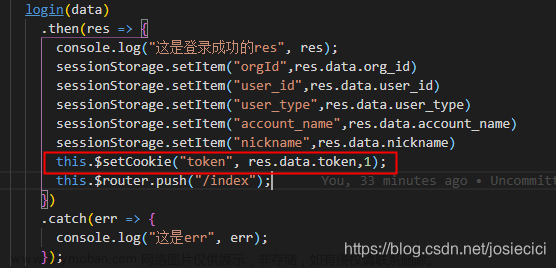pom.xml
<dependency>
<groupId>org.springframework.boot</groupId>
<artifactId>spring-boot-starter-websocket</artifactId>
</dependency>
<dependency>
<groupId>com.github.xiaoymin</groupId>
<artifactId>knife4j-openapi2-spring-boot-starter</artifactId>
<version>4.4.0</version>
</dependency>
<dependency>
<groupId>com.github.xiaoymin</groupId>
<artifactId>knife4j-openapi2-spring-boot-starter</artifactId>
<version>4.4.0</version>
</dependency>
2-1:WebSocketConfig
package com.test.order.ws;
import org.springframework.boot.web.servlet.FilterRegistrationBean;
import org.springframework.context.annotation.Bean;
import org.springframework.context.annotation.Configuration;
import org.springframework.web.socket.server.standard.ServerEndpointExporter;
@Configuration
public class WebSocketConfig {
/**
* 注入ServerEndpointExporter,
* 这个bean会自动注册使用了@ServerEndpoint注解声明的Websocket endpoint
*/
@Bean
public ServerEndpointExporter serverEndpointExporter() {
return new ServerEndpointExporter();
}
@Bean
public WebsocketFilter websocketFilter(){
return new WebsocketFilter();
}
@Bean
public FilterRegistrationBean getFilterRegistrationBean(){
FilterRegistrationBean bean = new FilterRegistrationBean();
bean.setFilter(websocketFilter());
//TODO 临时注释掉,测试下线上socket总断的问题,addUrlPatterns就会进行认证,没有添加的就无需认证
bean.addUrlPatterns("/taskCountSocket/*", "/websocket/*","/eoaSocket/*","/eoaNewChatSocket/*", "/newsWebsocket/*", "/vxeSocket/*");
return bean;
}
}
2-2:WebsocketFilter
package com.test.order.ws;
import com.test.order.config.CommonAPI;
import com.test.order.config.RedisUtil;
import lombok.extern.slf4j.Slf4j;
import javax.servlet.*;
import javax.servlet.http.HttpServletRequest;
import javax.servlet.http.HttpServletResponse;
import java.io.IOException;
/**
* websocket 前端将token放到子协议里传入 与后端建立连接时需要用到http协议,此处用于校验token的有效性
* @Author taoYan
* @Date 2022/4/21 17:01
**/
@Slf4j
public class WebsocketFilter implements Filter {
private static final String TOKEN_KEY = "Sec-WebSocket-Protocol";
private static CommonAPI commonApi;
private static RedisUtil redisUtil;
@Override
public void doFilter(ServletRequest servletRequest, ServletResponse servletResponse, FilterChain filterChain) throws IOException, ServletException {
if (commonApi == null) {
commonApi = SpringContextUtils.getBean(CommonAPI.class);
}
if (redisUtil == null) {
redisUtil = SpringContextUtils.getBean(RedisUtil.class);
}
HttpServletRequest request = (HttpServletRequest)servletRequest;
String token = request.getHeader(TOKEN_KEY);
log.debug("Websocket连接 Token安全校验,Path = {},token:{}", request.getRequestURI(), token);
try {
TokenUtils.verifyToken(token, commonApi, redisUtil);
} catch (Exception exception) {
//log.error("Websocket连接 Token安全校验失败,IP:{}, Token:{}, Path = {},异常:{}", oConvertUtils.getIpAddrByRequest(request), token, request.getRequestURI(), exception.getMessage());
log.debug("Websocket连接 Token安全校验失败,IP:{}, Token:{}, Path = {},异常:{}", oConvertUtils.getIpAddrByRequest(request), token, request.getRequestURI(), exception.getMessage());
return;
}
HttpServletResponse response = (HttpServletResponse)servletResponse;
response.setHeader(TOKEN_KEY, token);
filterChain.doFilter(servletRequest, servletResponse);
}
}
2-3:CommonAPI
package com.test.order.config;
import java.util.List;
import java.util.Map;
import java.util.Set;
/**
* 通用api
* @author: jeecg-boot
*/
public interface CommonAPI {
/**
* 1查询用户角色信息
* @param username
* @return
*/
Set<String> queryUserRoles(String username);
/**
* 2查询用户权限信息
* @param userId
* @return
*/
Set<String> queryUserAuths(String userId);
/**
* 6字典表的 翻译
* @param table
* @param text
* @param code
* @param key
* @return
*/
String translateDictFromTable(String table, String text, String code, String key);
/**
* 7普通字典的翻译
* @param code
* @param key
* @return
*/
String translateDict(String code, String key);
}
2-4:RedisUtil
//
// Source code recreated from a .class file by IntelliJ IDEA
// (powered by FernFlower decompiler)
//
package com.test.order.config;
import org.springframework.beans.factory.annotation.Autowired;
import org.springframework.data.redis.core.RedisTemplate;
import org.springframework.stereotype.Component;
import java.util.Arrays;
import java.util.List;
import java.util.Map;
import java.util.Set;
import java.util.concurrent.TimeUnit;
@Component
public class RedisUtil {
@Autowired
private RedisTemplate<String, Object> redisTemplate;
public RedisUtil() {
}
public boolean expire(String key, long time) {
try {
if (time > 0L) {
this.redisTemplate.expire(key, time, TimeUnit.SECONDS);
}
return true;
} catch (Exception var5) {
var5.printStackTrace();
return false;
}
}
public long getExpire(String key) {
return this.redisTemplate.getExpire(key, TimeUnit.SECONDS);
}
public boolean hasKey(String key) {
try {
return this.redisTemplate.hasKey(key);
} catch (Exception var3) {
var3.printStackTrace();
return false;
}
}
public void del(String... key) {
if (key != null && key.length > 0) {
if (key.length == 1) {
this.redisTemplate.delete(key[0]);
} else {
this.redisTemplate.delete(Arrays.asList(key));
}
}
}
public Object get(String key) {
return key == null ? null : this.redisTemplate.opsForValue().get(key);
}
public boolean set(String key, Object value) {
try {
this.redisTemplate.opsForValue().set(key, value);
return true;
} catch (Exception var4) {
var4.printStackTrace();
return false;
}
}
public boolean set(String key, Object value, long time) {
try {
if (time > 0L) {
this.redisTemplate.opsForValue().set(key, value, time, TimeUnit.SECONDS);
} else {
this.set(key, value);
}
return true;
} catch (Exception var6) {
var6.printStackTrace();
return false;
}
}
public long incr(String key, long delta) {
if (delta < 0L) {
throw new RuntimeException("递增因子必须大于0");
} else {
return this.redisTemplate.opsForValue().increment(key, delta);
}
}
public long decr(String key, long delta) {
if (delta < 0L) {
throw new RuntimeException("递减因子必须大于0");
} else {
return this.redisTemplate.opsForValue().increment(key, -delta);
}
}
public Object hget(String key, String item) {
return this.redisTemplate.opsForHash().get(key, item);
}
public Map<Object, Object> hmget(String key) {
return this.redisTemplate.opsForHash().entries(key);
}
public boolean hmset(String key, Map<String, Object> map) {
try {
this.redisTemplate.opsForHash().putAll(key, map);
return true;
} catch (Exception var4) {
var4.printStackTrace();
return false;
}
}
public boolean hmset(String key, Map<String, Object> map, long time) {
try {
this.redisTemplate.opsForHash().putAll(key, map);
if (time > 0L) {
this.expire(key, time);
}
return true;
} catch (Exception var6) {
var6.printStackTrace();
return false;
}
}
public boolean hset(String key, String item, Object value) {
try {
this.redisTemplate.opsForHash().put(key, item, value);
return true;
} catch (Exception var5) {
var5.printStackTrace();
return false;
}
}
public boolean hset(String key, String item, Object value, long time) {
try {
this.redisTemplate.opsForHash().put(key, item, value);
if (time > 0L) {
this.expire(key, time);
}
return true;
} catch (Exception var7) {
var7.printStackTrace();
return false;
}
}
public void hdel(String key, Object... item) {
this.redisTemplate.opsForHash().delete(key, item);
}
public boolean hHasKey(String key, String item) {
return this.redisTemplate.opsForHash().hasKey(key, item);
}
public double hincr(String key, String item, double by) {
return this.redisTemplate.opsForHash().increment(key, item, by);
}
public double hdecr(String key, String item, double by) {
return this.redisTemplate.opsForHash().increment(key, item, -by);
}
public Set<Object> sGet(String key) {
try {
return this.redisTemplate.opsForSet().members(key);
} catch (Exception var3) {
var3.printStackTrace();
return null;
}
}
public boolean sHasKey(String key, Object value) {
try {
return this.redisTemplate.opsForSet().isMember(key, value);
} catch (Exception var4) {
var4.printStackTrace();
return false;
}
}
public long sSet(String key, Object... values) {
try {
return this.redisTemplate.opsForSet().add(key, values);
} catch (Exception var4) {
var4.printStackTrace();
return 0L;
}
}
public long sSetAndTime(String key, long time, Object... values) {
try {
Long count = this.redisTemplate.opsForSet().add(key, values);
if (time > 0L) {
this.expire(key, time);
}
return count;
} catch (Exception var6) {
var6.printStackTrace();
return 0L;
}
}
public long sGetSetSize(String key) {
try {
return this.redisTemplate.opsForSet().size(key);
} catch (Exception var3) {
var3.printStackTrace();
return 0L;
}
}
public long setRemove(String key, Object... values) {
try {
Long count = this.redisTemplate.opsForSet().remove(key, values);
return count;
} catch (Exception var4) {
var4.printStackTrace();
return 0L;
}
}
public List<Object> lGet(String key, long start, long end) {
try {
return this.redisTemplate.opsForList().range(key, start, end);
} catch (Exception var7) {
var7.printStackTrace();
return null;
}
}
public long lGetListSize(String key) {
try {
return this.redisTemplate.opsForList().size(key);
} catch (Exception var3) {
var3.printStackTrace();
return 0L;
}
}
public Object lGetIndex(String key, long index) {
try {
return this.redisTemplate.opsForList().index(key, index);
} catch (Exception var5) {
var5.printStackTrace();
return null;
}
}
public boolean lSet(String key, Object value) {
try {
this.redisTemplate.opsForList().rightPush(key, value);
return true;
} catch (Exception var4) {
var4.printStackTrace();
return false;
}
}
public boolean lSet(String key, Object value, long time) {
try {
this.redisTemplate.opsForList().rightPush(key, value);
if (time > 0L) {
this.expire(key, time);
}
return true;
} catch (Exception var6) {
var6.printStackTrace();
return false;
}
}
public boolean lSet(String key, List<Object> value) {
try {
this.redisTemplate.opsForList().rightPushAll(key, value);
return true;
} catch (Exception var4) {
var4.printStackTrace();
return false;
}
}
public boolean lSet(String key, List<Object> value, long time) {
try {
this.redisTemplate.opsForList().rightPushAll(key, value);
if (time > 0L) {
this.expire(key, time);
}
return true;
} catch (Exception var6) {
var6.printStackTrace();
return false;
}
}
public boolean lUpdateIndex(String key, long index, Object value) {
try {
this.redisTemplate.opsForList().set(key, index, value);
return true;
} catch (Exception var6) {
var6.printStackTrace();
return false;
}
}
public long lRemove(String key, long count, Object value) {
try {
Long remove = this.redisTemplate.opsForList().remove(key, count, value);
return remove;
} catch (Exception var6) {
var6.printStackTrace();
return 0L;
}
}
}
2-5:SpringContextUtils
package com.test.order.ws;
import javax.servlet.http.HttpServletRequest;
import javax.servlet.http.HttpServletResponse;
import org.jeecg.common.constant.CommonConstant;
import org.jeecg.common.constant.ServiceNameConstants;
import org.springframework.beans.BeansException;
import org.springframework.context.ApplicationContext;
import org.springframework.context.ApplicationContextAware;
import org.springframework.stereotype.Component;
import org.springframework.web.context.request.RequestContextHolder;
import org.springframework.web.context.request.ServletRequestAttributes;
/**
* @Description: spring上下文工具类
* @author: jeecg-boot
*/
@Component
public class SpringContextUtils implements ApplicationContextAware {
/**
* 上下文对象实例
*/
private static ApplicationContext applicationContext;
@Override
public void setApplicationContext(ApplicationContext applicationContext) throws BeansException {
SpringContextUtils.applicationContext = applicationContext;
}
/**
* 获取applicationContext
*
* @return
*/
public static ApplicationContext getApplicationContext() {
return applicationContext;
}
/**
* 获取HttpServletRequest
*/
public static HttpServletRequest getHttpServletRequest() {
return ((ServletRequestAttributes) RequestContextHolder.getRequestAttributes()).getRequest();
}
/**
* 获取HttpServletResponse
*/
public static HttpServletResponse getHttpServletResponse() {
return ((ServletRequestAttributes) RequestContextHolder.getRequestAttributes()).getResponse();
}
/**
* 获取项目根路径 basePath
*/
public static String getDomain(){
HttpServletRequest request = getHttpServletRequest();
StringBuffer url = request.getRequestURL();
//1.微服务情况下,获取gateway的basePath
String basePath = request.getHeader(ServiceNameConstants.X_GATEWAY_BASE_PATH);
if(oConvertUtils.isNotEmpty(basePath)){
return basePath;
}else{
String domain = url.delete(url.length() - request.getRequestURI().length(), url.length()).toString();
//2.【兼容】SSL认证之后,request.getScheme()获取不到https的问题
// https://blog.csdn.net/weixin_34376986/article/details/89767950
String scheme = request.getHeader(CommonConstant.X_FORWARDED_SCHEME);
if(scheme!=null && !request.getScheme().equals(scheme)){
domain = domain.replace(request.getScheme(),scheme);
}
return domain;
}
}
public static String getOrigin(){
HttpServletRequest request = getHttpServletRequest();
return request.getHeader("Origin");
}
/**
* 通过name获取 Bean.
*
* @param name
* @return
*/
public static Object getBean(String name) {
return getApplicationContext().getBean(name);
}
/**
* 通过class获取Bean.
*
* @param clazz
* @param <T>
* @return
*/
public static <T> T getBean(Class<T> clazz) {
return getApplicationContext().getBean(clazz);
}
/**
* 通过name,以及Clazz返回指定的Bean
*
* @param name
* @param clazz
* @param <T>
* @return
*/
public static <T> T getBean(String name, Class<T> clazz) {
return getApplicationContext().getBean(name, clazz);
}
}
多余就不写,照着jeecgboot代码搬就行了
文章来源地址https://www.toymoban.com/news/detail-857546.html
文章来源:https://www.toymoban.com/news/detail-857546.html
到了这里,关于WebSocketServer的使用(@ServerEndpoint添加过滤和token认证)的文章就介绍完了。如果您还想了解更多内容,请在右上角搜索TOY模板网以前的文章或继续浏览下面的相关文章,希望大家以后多多支持TOY模板网!












